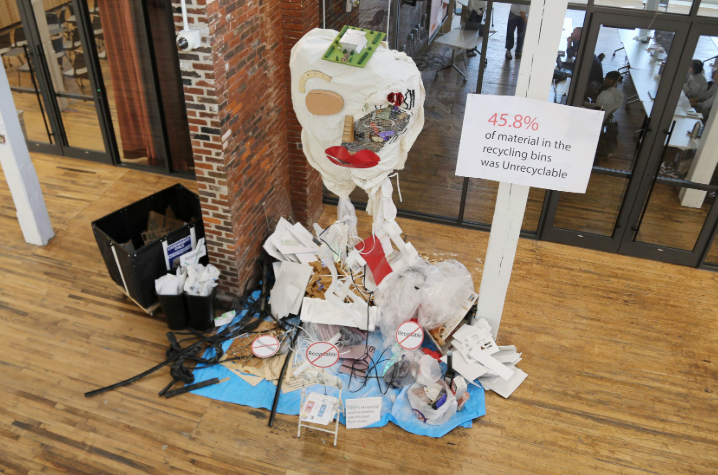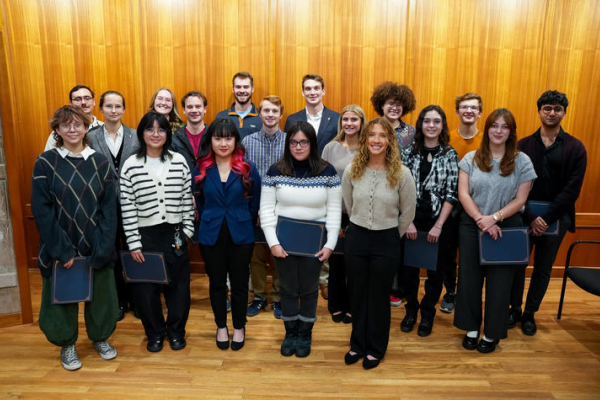Recycling redefined: Interiors student research turns waste into art and opportunity

At the end of each semester, University of Kentucky College of Design students are tasked with cleaning their studio space, removing any of the semester’s projects and organizing their materials before heading off for break. Junior interiors student Jackie Skeeters and School of Interiors faculty are looking at ways to make this process more environmentally sustainable by building awareness around the college and university’s recycling efforts.
Their research project “Immersive Recycling: The Merging of Art and Audits to Encourage Behavioral Change” examined interior design students’ sustainable behaviors, particularly regarding recycling, and the factors influencing their attitudes toward sustainability. Despite students being exposed to sustainable design principles in their coursework, these courses often utilize paper-based materials, contributing to waste, which raises questions about whether they are applying sustainability in practice.
The study aimed to assess behavioral change as a result of multiple interventions, including waste audits, interactive art installations and a comparative analysis between the waste collected at UK and the waste collected at partnering institution University of North Carolina-Greensboro, which planned to adopt the same waste audit and immersive art strategies.
The study started with an audit of the recycling system within the Gray Design Building. During the audit, Skeeters and School of Interiors Director Helen Turner gathered all recycling bins in the building and sorted the contents based on what was recyclable and what was not.
Following the audit, Skeeters produced a flyer to raise awareness about the issues the team uncovered, such as nonrecyclable materials being placed in the recycling bins and the waste of materials that could be donated for future use. The flyer includes guidelines on what materials can be recycled as well as specialized recycling locations in the building for scrap wood and metal.
“While UK Recycling already has some flyers and handouts, they often don’t include guidelines on the type of materials that design students are using like foam core, trace paper and wood,” Skeeters said while presenting her findings and flyer at an all-school meeting. “Our programs and projects are unique, and they pose unique recycling situations. So, it only makes sense to have a unique, specified flyer for us.”
In hopes of getting these findings in front of more students, Skeeters also worked with Jennifer Meakins, assistant professor in the School of Interiors, to develop an immersive installation in the lobby of the Gray Design Building using the materials from the waste audit. The team members hoped this physical manifestation of waste located in a prominent area would encourage students and viewers to discuss recycling and waste reduction and possibly adopt more sustainable recycling behaviors.
Skeeters received an undergraduate research fellowship from the college to continue her work on this project. She was also selected to participate in Kentucky’s 23rd annual Posters-at-the-Capitol event, where she presented a research poster about the project to event attendees, including state legislators. In April, team members also presented their findings at the National Conference on Undergraduate Research in Pittsburgh.
Following the spring semester, Skeeters and Turner completed their follow-up audit to see if their flyer and art installation had any impact on raising awareness of proper recycling in the building.
“While we still found a bit of unrecyclable material, it was better,” Skeeters said. “We went from around 150 pounds of unrecyclable material at the end of the Fall 2024 semester to 78 pounds at the end of the Spring 2025 semester, which is a huge improvement.”
Inspired by the idea that much of what she found during the audit was actually reusable materials suitable for future use and recognizing that design students face higher material costs and greater waste from physical project work, Skeeters decided to continue her sustainability research throughout the summer with a new focus on creating a designated reuse room for these materials to be stored in and accessed by students who may need them. Under the mentorship of Meakins, Skeeters secured the Commonwealth Undergraduate Research Experience (CURE) Fellowship to fund the continuation of her research through the summer term.
Supported by a $5,000 CURE Fellowship stipend, Skeeters spent 200 hours during the summer working on her new project titled “Reuse Room: Making Design Education More Sustainable and Equitable.” The project aimed to create a space where students can donate and reuse leftover materials, reducing financial strain and landfill waste. Through research on existing reuse centers, collaboration with faculty and the student council, and careful planning for accessibility and sustainability, Skeeters and Meakins developed a pitch for a permanent reuse room in the basement of the Gray Design Building.
“Currently, the reusable materials are housed on a metal shelving unit in the right corner of the entrance to the basement. Jenny and I are meeting with the main people in charge of facilities for final approval to start making a more permanent room,” Skeeters said. “Then we have to work out the logistical stuff like storage shelves and focus on the fun details like signage and operations.”
After the reuse room is physically completed, there is still work to be done.
“Once the room is built, that’s when the real work begins,” Skeeters said. “Its success will depend on the collective commitment of our community, students and faculty alike, to donate, share and make use of the materials. We’re hoping to collaborate with one of the design classes to create promotional materials and help spread the word, so the reuse room becomes an active, ongoing resource for everyone.”
Ultimately, Skeeters’s research journey not only benefited her fellow students but also her future career.
“I think this project has helped me grow into a more well-rounded designer,” Skeeters said. “I hope to become a professor one day, and this experience has given me a glimpse into what that path could look like, from conducting research to building meaningful connections within the university. I’ve learned that I really enjoy the research process, especially when it’s tied to something I’m passionate about. Whether it’s sustainability or another area that sparks my interest, I can see myself continuing this work in the future, and who knows, the challenges that come from this project might just inspire the next one.”


